Brisbane poincianas have been suffering from a plague of caterpillars. The caterpillars are defoliating the poincianas, descending from trees and infesting local residents properties.
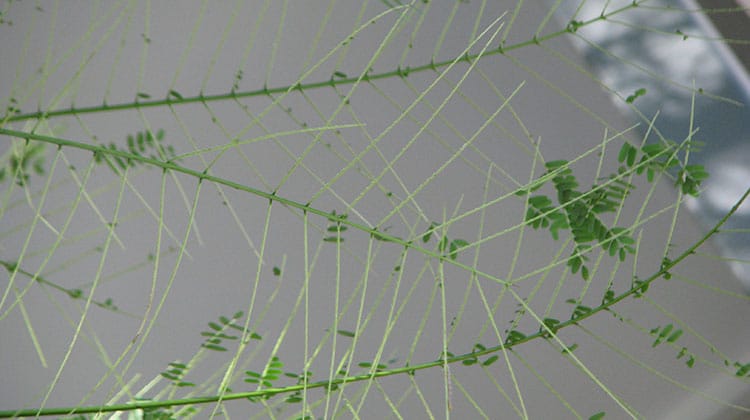 The caterpillar plague is a phenomenon that occurs around once every seven years in Brisbane. Unfortunately, past caterpillar events have shown that poincianas badly attacked by the caterpillars (or inchworms) often die the following year.
The caterpillar plague is a phenomenon that occurs around once every seven years in Brisbane. Unfortunately, past caterpillar events have shown that poincianas badly attacked by the caterpillars (or inchworms) often die the following year.
Poinciana caterpillars (Pericyma cruegeri) occur in most native Asian habitats of the Caesalpiniceae family (of which poinciana is the only one common locally). They have also become naturalised in Queensland and northern New South Wales.
The bad news is there’s still some time left in the caterpillar invasion, at the time of writing this article. They are currently green caterpillars of around 3-4cm in length. They grow to around 7cm, changing colour to a mottled brown. The good news is that treatment is available.
We have a multi-prong approach to dealing with poinciana caterpillars. We start by raking debris (mulch, leaf litter and sticks) away from the base of the tree. Then we surround the poincianas trunk with diatomaceous earth. Diatomaceous earth is a fine sand consisting of very sharp grains. It discourages caterpillars from crossing to the tree.
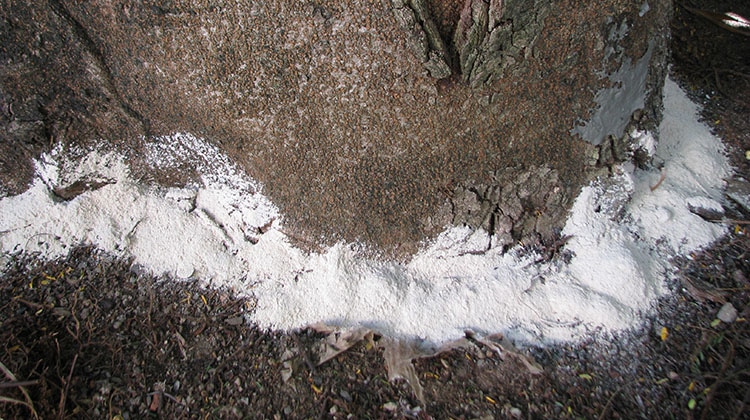 We then apply a tree barrier around 45 cm above the root crown. This is to protect the tree from the horticultural glue we apply. Horticultural glue stays sticky even when it dries, and caterpillars are unable to reach the leaves of the tree.
We then apply a tree barrier around 45 cm above the root crown. This is to protect the tree from the horticultural glue we apply. Horticultural glue stays sticky even when it dries, and caterpillars are unable to reach the leaves of the tree.
This causes the death of the inchworms in two ways. First, they are unable to reach the foliage to feed. They will either move on or starve. Secondly, they mate in trees. Being unable to reach the upper limbs ends the life-cycle of the caterpillar.
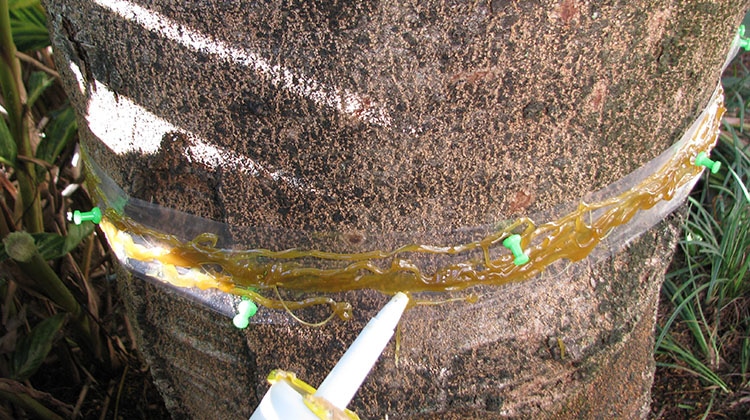 To immediately kill caterpillars on the poinciana and around it, we also spray them with Bacillus thuringiensis or Bt. The strain of Bacillus thuringiensis we use is so targeted that it only kills organisms that feed on leaves. Other Bt. strains are used on insects in cropping.
To immediately kill caterpillars on the poinciana and around it, we also spray them with Bacillus thuringiensis or Bt. The strain of Bacillus thuringiensis we use is so targeted that it only kills organisms that feed on leaves. Other Bt. strains are used on insects in cropping.
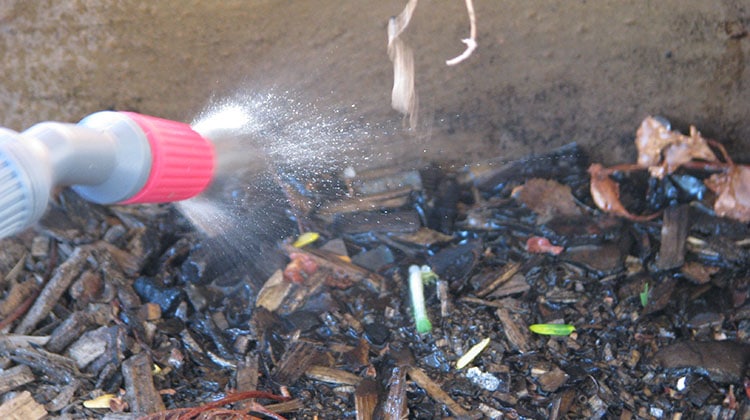 Some Brisbane residents have been calling in pest controllers. Unfortunately, this pest really can’t be controlled with chemicals. Most insecticides are systemic, meaning they are sprayed on trees or plants and the insect dies when it sucks on the sap of the plant. While caterpillars are insects, even systemic chemicals targeted to them won’t kill them as they don’t ingest enough sap from eating poinciana leaves.
Some Brisbane residents have been calling in pest controllers. Unfortunately, this pest really can’t be controlled with chemicals. Most insecticides are systemic, meaning they are sprayed on trees or plants and the insect dies when it sucks on the sap of the plant. While caterpillars are insects, even systemic chemicals targeted to them won’t kill them as they don’t ingest enough sap from eating poinciana leaves.
Further, Carbaryl, the chemical usually used against caterpillars, only kills caterpillars on contact. Every caterpillar has to be sprayed. It’s just as effective to crush caterpillars manually.
In fact, killing them by hand is helpful, and much less dangerous than using Carbaryl. Carbaryl is dangerous to humans and isn’t particularly selective. It also kills ladybirds and other beneficial insects that kill the caterpillars.
Our service costs from $189, more for large trees and for heavy infestations. It includes
- diatomaceous earth
- installation of tree band with horticultural glue
- spraying with Bacillus thuringiensis.
We also follow up by respraying Bt. if there is heavy rain within three days of the original spraying. While this treatment should kill all of your caterpillars, if a few do remain they won’t be able to damage your poinciana further due to the barriers in place.
David’s field notes
Interestingly, of four poincianas I examined today that were infested with caterpillars, three of them have suffered from poor pruning techniques over the last year. Trees have natural defenses against organisms attacking them, bio-chemicals in sap. If they are suffering from external stress their defenses are lowered leaving them more vulnerable to attack.
The moral of the story is to ensure the health of your trees and use only an arborist to avoid further tree problems later down the track.

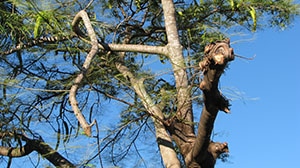
Hi David,
Thanks for your blog, I have noticed a huge amount of caterpillar droppings around my poinciana tree starting up again this season. The caterpillars are obviously there, but I can’t see them climbing up the trunk ATM. Could you confirm the council is trialing some type of biological solution in an attempt to control this pest?
I have a large poinciana now enduring a second wave of loopers. I have watched them drop from the tree and spin their cocoons wherever they can. Then they emerge and there are lots of moths everywhere. Isn’t it the moths that will be doing the mating? And do they then lay their eggs in the ground? And the baby caterpillars then climb up the tree to start the cycle again? Since you are recommending the sticky barrier?
Hi I have notice the last few days green worms dropping and heaps of birds eatting the worms. Foliage is now starting to get less in some spots you to covid 9 and not really alowed to leave the premise what would the best thing to do . The tree is about 20 years old we have a deck underneath the tree on three sides
Hi David,
I noticed the caterpillar/ moth problem around 3-4 weeks ago due to the incessant and recurring droppings on outdoor tiles. I was sweeping them twice a day and could have done it five times. I only realised what it was on Friday just gone noticing our two poincianas both being heavily stripped on lower branches then finding your website assuring me I wasn’t going mad.
How long does the infestation last?
Thanks for your website.
Paul
Hi David I am having a problem with large numbers of Poinciana caterpillars ( Loopers). My poinciana is over 50 years old and very large. How do you spray with Bacillus thuringiensis on tall trees?
Regards
Hi David, can you let me know if removing green seed pods will let the tree have more energy to naturally fight the pests? We had the most flowers we have ever had this summer and tree was seemingly doing very well but it is now under attack
march 25th Brisbane, we also had the best flowering season and now the inchworms are back! is less than 7yrs though… I think it’s only been 3 yrs since they were here and striped every tree in new farm, hawthorne and more! what do you do if they are already in the tree? I don’t have any climbing up! we spray the branches with a blast of water and then stomp on all the worms that drop! poor Brisbane about to lose more trees 🙁
David, I am an absolute failure as a gardener – truly bad – so I don’t have anything to do with plants. However I just came upon your article on Poincianas. Most interesting and well written piece I have read in a long time. Thank you for all the information and congratulations on your knowledge.
Hi David,
Thanks for your blog, though I think in my case the information is too late. Since the flooding in Townsville, I have notice huge amounts of caterpillar droppings around my 12 year old tree and now the caterpillars are on the move and whilst I will step on any I see, it might not make much difference. I will try your suggestions anyway. Do you have a picture of the moth/butterfly involved?
Hi David, we find that our currawongs are having a fine time feasting on the catepilars. They will sit in tree several times a day and pig out. Tony, northern nsw
Hi David,
Would you please advise me of what causes a poinciana tree to bleed sap.
Regards
Anne Jarvis
Hi Ann. There are several possible causes, so I’ll mention each to assist you in deducing which is the most likely. Firstly, injury. I list it first as it’s probably easy to rule out if you aren’t aware of any vehicles or yard tools (think whipper snippers) that may have caused it.
We then move on to biotic factors: pests and diseases. Both can cause bleeding and can be indicative of major health problems in this case. Longicorn borers are most likely if they are also present. Examine some dead wood and look for small holes, exit wounds. If a poinciana is stressed these can move into live wood and go unnoticed until they have done irrepairable damage to the tree. Unfortunately, the only defense is maintaining the health of the tree so it doesn’t get stressed to that point.
Finally, it’s possibly caused by a fungal infection. We can use a Phytopthera test kit to check, though we may be able to clinically diagnose it also.
I have a horrible feeling our 2 45 year poincianas are about to be hit by another plague of these pest. We had a serious problem last year but the trees fought back and have reasonable foliage but little flowers in the summer.
We live in Yabba St which is usually splendid in summer. HELP
I need your services
Hi David, Thanks for the great blog. Your site is the only place I have found this problem mentioned. Do you know what stage of the lifecycle the caterpillar is at now? As you said it is a 7 yearly problem usually, are you expecting another big infestation this summer or not?
Thanks, Gen
Hi Gen, it was great to catch up with you last Sunday at the community meeting about poinciana caterpillars. While the rule of thumb is 7 years, the proliferation of caterpillars already this year has me suspecting there may be some shift in an underlying environmental factor affecting the caterpillars.
Dear david yr blog was so very informative…..thankyou. have only noticed today that caterpillars have struck my poinciana.😭 i live just outside of alstonville nsw. Is there anyone here i could i could call on in my area. I dont trust myself to do it right. Hope i hear from you david.
Hi David, Thank you, I found this post very helpful and another feed you have been replying on a similar topic on your website. I wish I had read this a couple of months ago in order to have saved my tree. Now that the catepillar’s and leaves have gone, is there anything I can do to nurture my tree back to health? It is >50years old big beautiful old girl. Thank you
Hi Louise. Studies have demonstrated increased morbidity in defoliated trees that had previously been fertilized, so I suggest not adding nutrients to the soil. I can only suggest treating any remaining leaves with Bt if the tree is still suffering loss, and applying a tree band to block access to the tree from further infestation.
Your tree’s age may actually be an advantage as the same study I quoted above showed a positive correlation between diametre at breast height (DBH) and survival.